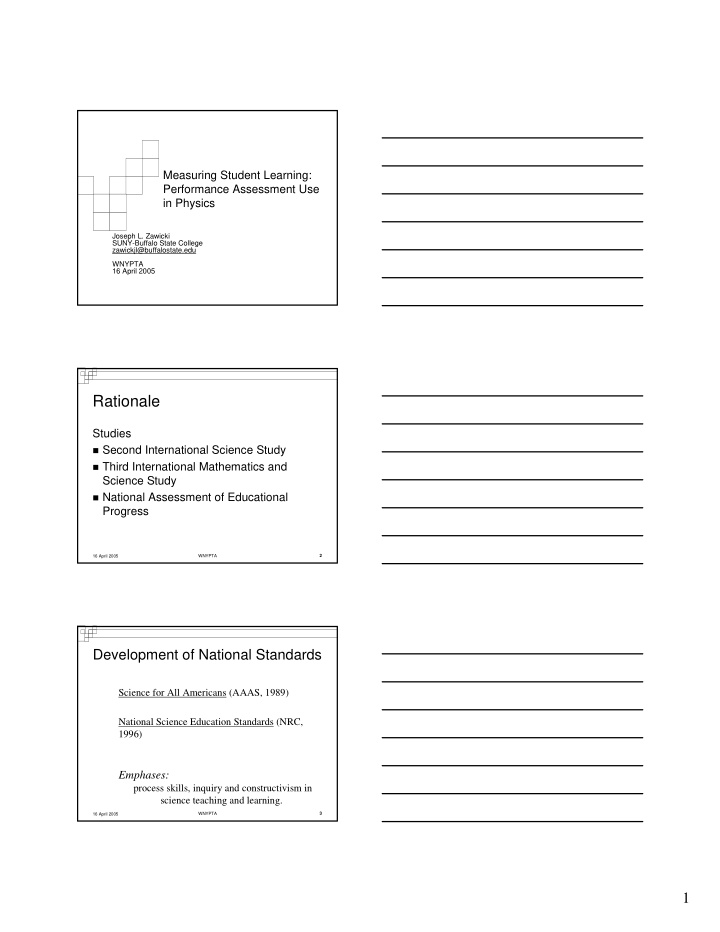



Measuring Student Learning: Performance Assessment Use in Physics Joseph L. Zawicki SUNY-Buffalo State College zawickjl@buffalostate.edu WNYPTA 16 April 2005 Rationale Studies � Second International Science Study � Third International Mathematics and Science Study � National Assessment of Educational Progress WNYPTA 2 16 April 2005 Development of National Standards Science for All Americans (AAAS, 1989) National Science Education Standards (NRC, 1996) Emphases: process skills, inquiry and constructivism in science teaching and learning. 3 16 April 2005 WNYPTA 1
Problem Solving Model* � Plan � Obtain data � Organize data � Analyze data � Generalize from the data � Make decisions based upon the data *New York State Regents Physics Syllabus, Appendix A (1988) 16 April 2005 WNYPTA 4 Process Skills Models Lunetta and Tamir (1979) - four foci: � Planning � Performing � Analyzing and interpreting � Application WNYPTA 5 16 April 2005 Development of NYS Standards � NYS Learning Standards in Mathematics, Science and Technology (NYSED, 1996) � Developed from the NSES and SFAA � Standards: 1 – Analysis, Inquiry and Design, Scientific Inquiry, 2 – Information Systems, 3 – Math, 4 – Science, 5 – Technology, 6 – Common Themes, 7 – Interdisciplinary Problem Solving 6 16 April 2005 WNYPTA 2
Curriculum Standards •Frameworks •Syllabi •Guides •Blueprints validit correlation •Benchmarks y •Instructional styles •Objective tests •Print materials •Performance assessments •Equipment •Portfolios •Facilities •Teacher Observations •Technology •Group Activities alignment •Community •Program Evaluations Assessment/Evaluation System Instructional Program 16 April 2005 WNYPTA 7 WNYPTA 8 16 April 2005 NYS Assessments � Multifaceted – Multiple Choice, Constructed Response, Extended Constructed Response � Performance Assessment Component – Part “D” � Various organizations � Integrated (Physics, Chemistry) � Independent (Earth Science) � Surrogate (Biology) 9 16 April 2005 WNYPTA 3
Dimensions of Performance Assessment Doran and Reynolds (1996): � Novelty � Structure � Sequence � Level Proposed: Organization 16 April 2005 WNYPTA 10 The Independent Model -- Features � Usually several stations � Separate foci (within general area/topic) � Several skills are tested � Less time per task (station) � Less “double jeopardy” WNYPTA 11 16 April 2005 The Surrogate Model -- Features � Assessment is a follow-up to a (prior) hands-on, in-class activity � Assessment calls for students to critique evidence (data/conclusions/plans) from other students � Assessment requires students to extend conclusions stated/predict to new investigation � Students use their prior experiences � No demand for equipment and materials � No safety concerns 12 16 April 2005 WNYPTA 4
The Integrated Model – Features � Usually single location (lab site) � A single overarching focus (context) � A family of skills assessed � Often a complete investigation 16 April 2005 WNYPTA 13 Today’s Agenda � Overview of Performance Assessment formats � Examples from � NORC Performance Assessment Task Collection � Sample task following current thinking for NYS Physical Setting: Physics � Questions/Concerns/Comments WNYPTA 14 16 April 2005 Thank you for your time and patience! Please feel free to contact me with questions, concerns or comments: Joseph L. Zawicki, STANYS Physics DAL Assistant Professor, Science Education Science #130, Buffalo State College 1300 Elmwood Avenue Buffalo, NY 14222-1095 Office: (716) 878-3800; Fax: (716) 878-4524 15 16 April 2005 WNYPTA 5
Recommend
More recommend